CrossFire Xpress 3200: RD580 for AM2
by Wesley Fink on June 1, 2006 12:05 AM EST- Posted in
- Motherboards
Standard Gaming Performance
We tested with our recently revised group of game tests, which includes Call of Duty 2, Serious Sam 2, Half Life 2: Lost Coast, F.E.A.R, Far Cry, and Splinter Cell: Chaos Theory. All boards were tested with the ATI X1900 XT with Catalyst 6.4 drivers and the NVIDIA 7900 GTX to allow direct comparison to other motherboard gaming results.
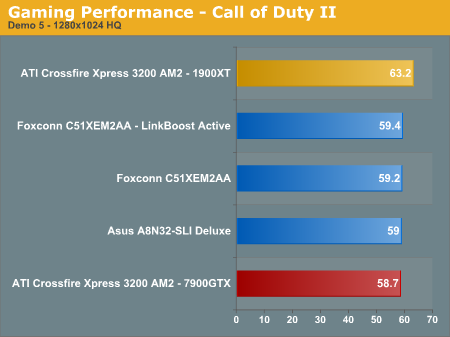
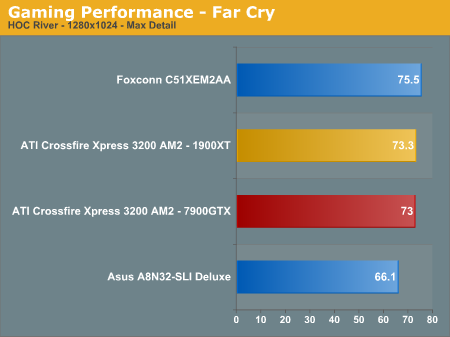
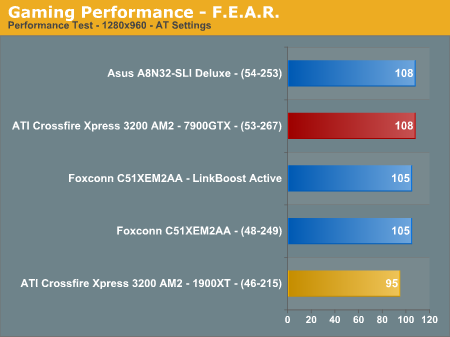
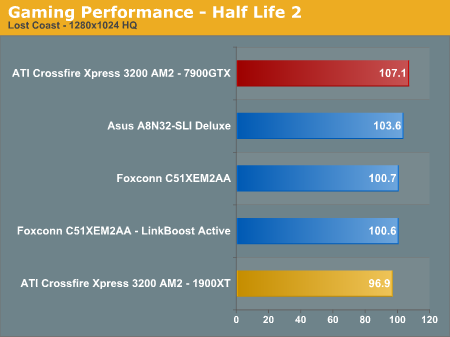
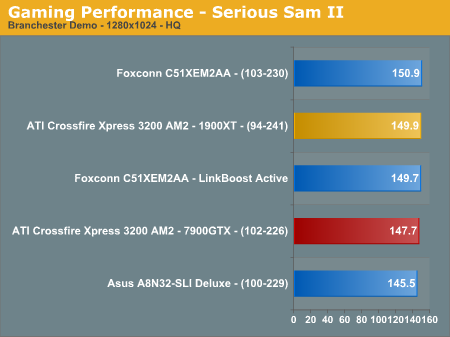

X1900 XT standard results are in gold, while NVIDIA 7900 GTX results on the ATI CrossFire Xpress 3200 AM2 are in red. Top performance was generally split among the games between the ATI board running X1900 XT and the Foxconn 590 running NVIDIA 7900 GTX. There was no knockout winner in standard gaming performance.
We tested with our recently revised group of game tests, which includes Call of Duty 2, Serious Sam 2, Half Life 2: Lost Coast, F.E.A.R, Far Cry, and Splinter Cell: Chaos Theory. All boards were tested with the ATI X1900 XT with Catalyst 6.4 drivers and the NVIDIA 7900 GTX to allow direct comparison to other motherboard gaming results.






X1900 XT standard results are in gold, while NVIDIA 7900 GTX results on the ATI CrossFire Xpress 3200 AM2 are in red. Top performance was generally split among the games between the ATI board running X1900 XT and the Foxconn 590 running NVIDIA 7900 GTX. There was no knockout winner in standard gaming performance.










71 Comments
View All Comments
JarredWalton - Thursday, June 1, 2006 - link
And you thought LinkBoost was fast! ;)Typo fixed, thanks.
Stele - Thursday, June 1, 2006 - link
A main attraction of HD audio over AC'97 other than 100.1 setups is probably better sound quality. As such, perhaps Anandtech needs to develop a test method and/or utility with which to assess precisely this aspect of motherboards' sound subsystems. Low CPU utilisation is well and good but ultimately it's reaching the point where these figures are fairly meaningless, as this review underscored.Instead, besides just testing CPU utilisation, Anandtech could test/measure characteristics such as SNR ratio, THD at a reference frequency etc. at the output ports. The test can then be rounded off with subjective hearing tests through reference speakers or headphones, e.g. for irritating crossover noise from the mouse (A7N8X anyone?) or some other EMI source, and so on.
That way, we can judge if a motherboard manufacturer's implementation and motherboard design are sound (pun intended) because ultimately, it's about what you hear, not see; an 8.1 with terrific speakers, built in DTS/AC3/etc and other paper-spec niceties isn't going to cut it if the codec was, say, jammed right next to the CPU PWM controller with barely any grounding.
Gary Key - Thursday, June 1, 2006 - link
We are still debating our "subjective" results and comments for the audio section. However, at some point this summer we will expand our testing to include additional testing outside the CPU utilization and game results.
Stele - Friday, June 2, 2006 - link
Subjective is, understandably, subjective. Thus such results are bound to differ depending on the person assessing the product as well as the circumstances under which the test was done. IMHO, it should therefore only play a small part in the extended test, complementing the objective, measured figures which should play the dominant role in an extended audio test.Indeed, accurately measuring such performance characteristics (SNR, THD, no-signal background noise level) would probably be more useful because even if the subjective part of the test is completely left out, the figures would generally be a sufficient gauge of the quality of the components and implementation (circuit design, manufacture etc).
Having said that, the subjective opinions do give the review a human perspective and a broader picture which numbers alone may not fully convey - another good example being noise level measurements. Again, nice to have but won't be fatal without it.
Just my 2 cents' :)
Beenthere - Thursday, June 1, 2006 - link
...and you can be certain that production mobos will NOT perform as well as the reference mobo. Expect Asus to use a hack design, DFI to have a pretty good design less proper ports, Sapphire to not have a clue at copying the ATI reference mobo, Abit to talk shitza but not deliver, etc. and the prices will be sky high. Ya gotta wonder how much longer people are going to buy crap mobos just because they have a good chipset?Stele - Thursday, June 1, 2006 - link
Perhaps it's because there're aren't many seriously viable choices - if any - other than the 'crap mobo' brands you listed? The manufacturers know this too, and rest in the relative comfort of the knowledge that since no brand's perfect, buyers aren't likely to suddenly all jump ship in a hurry. They're probably expecting people to grumble and complain, as always, but buy from one of them anyway... as always.xsilver - Thursday, June 1, 2006 - link
Does ATI have license to product intel chipsets either now or in the future?or was their some exclusivity when nvidia made their cross licensing agreement?
Gary Key - Thursday, June 1, 2006 - link
ATI has been producing Intel compatible chipsets for a few years now and we should see a "RD580" type chipset for Conroe later this summer.
fzkl - Thursday, June 1, 2006 - link
Why are the setups using different hard drives? The ATI system has a 16MB buffer whereas the Nvidia system has an 8 MB buffer. Does that contribute to any performance difference?peternelson - Thursday, June 1, 2006 - link
I spotted that too. I imagine the HD might change the PCMark result.